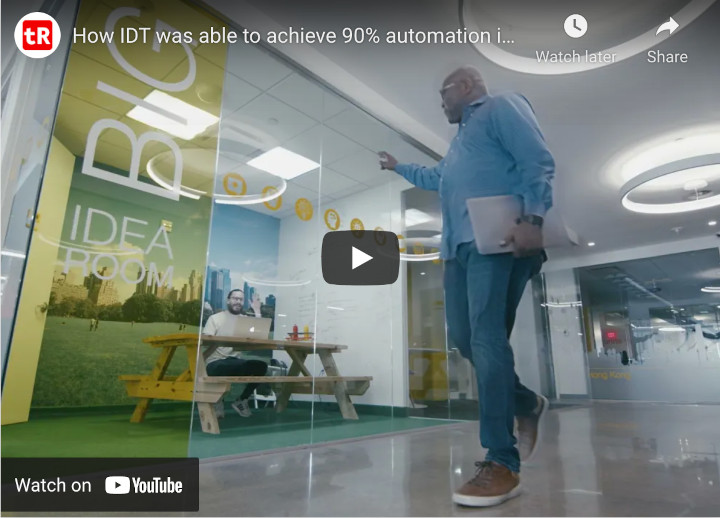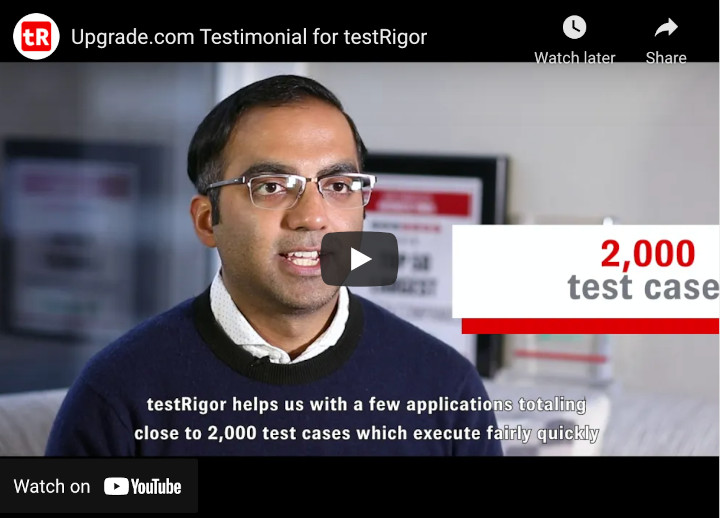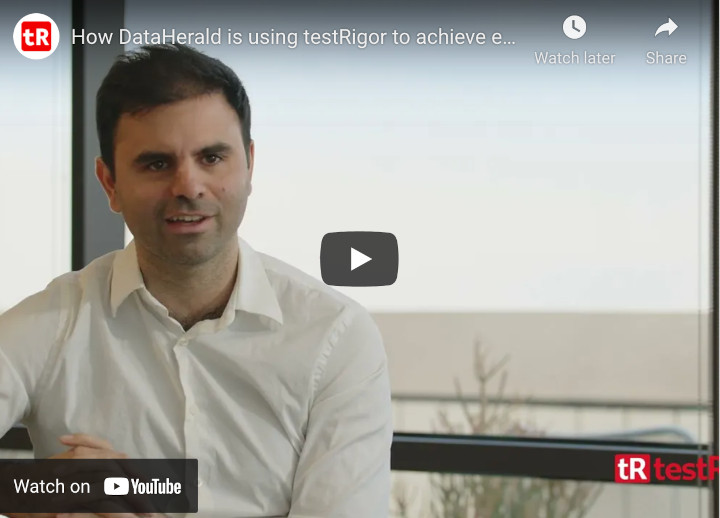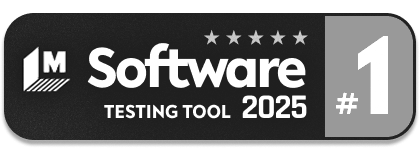testRigor Whitepaper
Introduction
It’s hard to overstate how challenging software development is today. The market for web, mobile, and desktop applications is more competitive than ever. Customers expect their applications to deliver a flawless and intuitive experience every time. Hiring and retaining high-quality software developers and engineers feels next to impossible, given the talent shortages emerging organizations are facing. How can companies balance these competing challenges and expectations? How can they scale their development operations effectively to deliver at speed without compromising the customer experience? This is where no-code test automation plays a key role.
testRigor, a codeless test automation platform, has emerged as a powerful AI-driven solution to address numerous limitations of legacy test automation tools. By adopting a more user-centric approach, testRigor allows organizations to efficiently create and maintain automated tests, ensuring the highest possible quality for their end-users. We will explore the evolution of test automation, the benefits and limitations of traditional tools, and the advantages of adopting testRigor. We will also share some practical examples of how testRigor has helped organizations optimize and drastically scale their testing processes.
Executive summary
testRigor is a comprehensive AI-based testing system that enables manual testers to develop complex end-to-end test automation without the need for coding skills. Organizations that have integrated testRigor into their development processes have experienced significant enhancements in the overall testing of their software products and reduction of defect escape rate.
testRigor is the only tool on the market that offers excellent scalability, allowing organizations that previously struggled to move away from manual QA or legacy test automation to achieve nearly 100% automation coverage, with only a modest initial investment needed. Moreover, testRigor pays for itself in just a few months. Its advanced AI engine, allowing for plain English test statements, generative AI test creation, simplified test creation and execution, and minimal maintenance, sets it apart from all other coded and no-code tools in the market.
testRigor serves as a comprehensive solution for testing web, native and hybrid mobile applications, native desktop applications, emails, SMS, phone calls, 2FA, downloaded files, databases, and more. It is ideally suited for functional regression, accessibility, load, and performance testing. testRigor is SOC2 and HIPAA compliant, and supports FDA 21 CFR Part 11 reporting.
Key Benefits:
- Achieve 90%+ test coverage within the first year of implementation
- 70-90% increase in regression test completion speed (depending on preceding solution)
- Up to 99.5% reduction in time spent towards test maintenance
- Defect escape rate approaches 0
- Decreased total QA expenditure
package tests; import org.openqa.selenium.By; import org.openqa.selenium.WebDriver; import org.openqa.selenium.WebElement; import org.openqa.selenium.chrome.ChromeDriver; import org.testing.Assert; import org.testing.annotations.AfterTest; import org.testing.annotations.BeforeTest; import org.testing.annotations.Test; public class TestSample { private WebDriver driver; @BeforeTest public void setUp() { System.setProperty("webdriver.chrome.driver", "path of driver"); driver = new ChromeDriver(); driver.manage().window().maximize(); } @Test public void login() { driver.get("https://www.browserstack.com/users/sign_in"); WebElement username = driver.findElement(By.id("user_email_login")); WebElementpassword = driver.findElement(By.id("user_password")); WebElement login = driver.findElement(By.name("commit")); username.sendKeys("abc@gmail.com"); password.sendKeys("your_password"); login.click(); WebElement welcomeElement = driver.findElement(By.xpath ("//*[@id=\"wpbody-content\"]/div[2]/header[2]/div/nav/ul/li[5]/a/span")); String welcomeText = welcomeElement.getText(); Assert.assertEquals(welcomeText, "Welcome Peter"); } @AfterTest public void tearDown() { driver.quit(); } }
login check if page contains "Welcome Peter"
In addition to the key benefits, testRigor provides numerous supplementary benefits that enhance an organization's QA teams and delivery processes. These additional benefits include upskilling manual QA professionals to own the automation process and eliminating the need for organizations to maintain their testing infrastructure. With a single click, users can execute their entire test suites for faster release cycles, and receive results in minutes.
Supplementary Benefits include:
- Greatly improved communication within the team leading to a more thorough test coverage
- Accelerated release cycles
- Detailed test results, allowing for seamless debugging
- No need for testing infrastructure
Organizations have observed convincing results upon implementing testRigor. Total test coverage has significantly increased for all users, leading to a reduced defect escape rate. testRigor was also the first company in the market to address the test maintenance challenge effectively.
An Overview of testRigor's Unique Approach
testRigor is a cloud-based, end-to-end AI-driven testing system that empowers manual QA professionals to develop complex, stable automated tests quickly and efficiently. This highly scalable no-installation, no-infrastructure solution uses plain-English natural language processing to author tests. By taking your existing manual test cases and making minimal adjustments, testRigor converts them into automated test cases.
As a Software as a Service (SaaS) solution, testRigor enables seamless cross-operation between web, mobile, and desktop testing. The common barrier between manual and automated QA professionals is eliminated, allowing all team members to actively participate in writing, editing, and maintaining tests. Engineering resources are freed up to focus on complex engineering tasks while QA focuses on covering the end-to-end user flows. The system establishes abstraction from details of implementation, ensuring tests remain valid even after underlying framework changes or refactoring. testRigor’s approach offers excellent visibility, ensuring that tests accurately target the intended aspects of the application.
To outline the benefits, costs, and risks associated with investing in the testRigor product, we interviewed five clients who vary in size and development practices. These interviews provide valuable insights into the real-world advantages of using testRigor.
Case Studies
Before using testRigor, customers were either unsuccessful with previous test automation attempts or still relying on manual end-to-end testing.
- Slow and error-prone manual testing processes
- Test automation frameworks requiring technical programming knowledge, complex setup, and slow test creation speed
- High test case maintenance resource demands
- New hires struggling with existing test automation systems
- Difficulty scaling test coverage
- Bottlenecks in development schedules due to test automation constraints
As a result, customers either abandoned their previous automated testing systems, did not seek out improved systems, or increased human resources and costs to address the testing problem. The complexity and brittleness of traditional systems made test automation unsustainable, negatively impacting the development and testing teams.
The case studies revealed that investing in testRigor enabled organizations once hindered by test maintenance overload to achieve 90%+ coverage. Furthermore, the time spent on manual testing of a regression test suite involving 10 testers for 1.5 hours (15 human-hours total) was reduced to just 40 minutes with automated testing. This allowed manual testers to create sophisticated and reliable automated tests, replacing the need for highly paid engineers. Team morale improved significantly by eliminating mundane regression testing tasks. Only a tiny percentage representing the most challenging tests to automate remained manual.
Each case study highlighted that development and deployment time cycles improved after adopting testRigor. The ease of transitioning test cases, whether through test case recording, generative AI test creation, or copy-pasting existing manual test cases, contributed to the accelerated creation of test suites.
A key advantage of testRigor is its solution for the test maintenance problem. Minimal test maintenance is required over releases, even when underlying software frameworks or code implementations change. This factor drives organizations to adopt testRigor across their enterprise.
All organizations in the study considered manual QA as a crucial resource in their development processes. These time-constrained resources needed a way to transition into automation testers and scale their output and efficiency effectively.
Key Results and Customer Testimonials
Quantified Benefits
- Increased test coverage to 90%+ within a 1-year period for large enterprises: testRigor has significantly aided organizations struggling with test coverage previously unable to trespass 10% to 33%. Upon implementing testRigor, organizations have reported at least doubling their test creation rate. One organization noted that a manual tester could now create 8 test cases part-time more efficiently than an automation engineer creating 4 test cases. Another organization was able to automate over 22,000 tests. Additionally, a different organization mentioned a 5% -10% test coverage increase with each release. A key factor for these organizations in increasing test coverage was the reduced maintenance required, allowing team members to focus on developing more tests.
- Users reported up to 99.5% less test maintenance: All organizations admitted that test maintenance with their previous automation systems was unmanageable, hindering new test case creation. After switching to testRigor, teams reported spending little to no time maintaining test cases. One organization cited spending less than 0.5 hours per week on test maintenance. The stability of testRigor's test cases encourages organizations to create more tests, directly leading to an increased overall test coverage. This stability allows engineers to focus on more critical technical tasks, while manual testers can create robust, meaningful tests.
- 70-90% speed increase in regression test completion: Organizations unanimously value time as a crucial resource. With testRigor, they were able to reduce manual testing time to hours using plain English test cases and parallel testing automation. Organizations shifted from scaling personnel to scaling processing power to perform the same manual tests across multiple browsers, devices, and operating systems. The linear approach to manual testing was replaced by running multiple tests simultaneously in parallel from a single location. One customer eliminated 20 person-days of testing, completing all test cases in 4-6 hours of weekly automation. Another customer experienced a significant reduction in their regression test completion time.




Unquantified Benefits
Empowering Manual QA to Become Sophisticated Automation Testers:
Organizations utilizing testRigor found that manual testers took ownership of the automation process and felt more valuable in the testing process. This improved the manual testers' personal value and the value the organization derived from them. With testRigor, manual testers were able to build more stable tests faster than previous automation engineers, allowing less technical manual testers to become the automation team.
Higher Code Coverage and More Reliable Products:
Each organization experienced an increase in product quality due to the higher test coverage achieved with testRigor. The time saved from creating plain English test scripts and reduced test maintenance allowed manual testers to create comprehensive test cases across the entire application. One organization reported that 80% of their test cases were UI-heavy, and automating these tests freed up substantial time to focus on other areas of automation. Previously, automation engineers struggled to keep up with the demand for new test cases and maintenance, but with testRigor, organizations achieved 90%+ test coverage, resulting in stronger, more reliable products.
Faster Release Cycles with Automated Testing:
After implementing testRigor, organizations saw their testing and release cycles increase exponentially as they created automated tests and approached 90% testing coverage. One organization scaled their releases fourfold, from 2 per year to 8 or more. Using testRigor as their end-to-end testing tool, all of the organizations experienced significant time savings in both test case creation and test execution. It's also worth noting that manual QA became responsible for creating and running automated regression tests, smoke tests, and sanity tests, allowing organizations to repurpose automation engineers for more technical tasks.



Conclusion and Future Outlook
In conclusion, the implementation of testRigor as a no-code end-to-end testing system has proven to be a game-changer for organizations seeking to improve their software development and testing processes. By empowering manual QA testers to become skilled automation testers, testRigor has enabled organizations to achieve higher test coverage, create more reliable products, and accelerate release cycles.
As the demands of the software development landscape continue to evolve, testRigor offers a robust, user-friendly solution that addresses the pain points faced by organizations in their quest for higher quality software and quicker release cycles. Embracing testRigor as an integral part of the software development process can help organizations achieve a competitive edge and deliver outstanding customer experiences.
The use of plain English test scripts allowing for much faster test authoring, reduced test maintenance, and scalable parallel testing have made it possible for organizations to overcome the challenges of traditional automation testing and repurpose resources more effectively. The case studies highlighted in this whitepaper demonstrate the tangible benefits of investing in testRigor, including increased test coverage, faster regression test completion, improved team morale, and decreased expenditure.
Upcoming plans for testRigor include enhancing the use of AI and Generative AI to expedite test case creation even further, and optimize the test development process to the greatest extent technically achievable.







